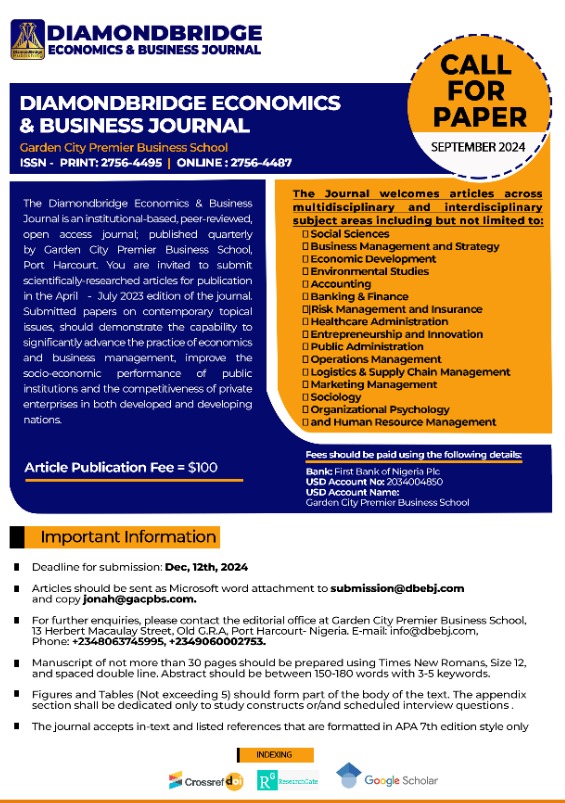
Authors’ Guidelines
How to submit your manuscript
Manuscripts should be submitted by one of the authors perhaps, the corresponding author through the online manuscript submission system or as directed by the editor. Only a manuscript submitted by one of the authors will be accepted. Authors are advised to submit electronic MS-Word files through the online submission system. If for some technical reason online submission is not successful, the author can submit the manuscript to
[email protected] and copy [email protected]
All submitted manuscripts to DBEBJ shall be subjected to a plagiarism check where an acceptable tolerance limit of 20% shall be applied. Authors should note that once a manuscript is submitted to DBEBJ, it is unethical to submit the same to any other publisher for whatever reason. Hence, the submitted manuscript should not have been previously published in any form.
Title, Keywords and Abstracts
The acceptable medium of all correspondences with the journal is English language. Hence, manuscript should be written in good English. Title, author(s), and affiliations should all be included on the title page as the first page of the manuscript file, followed by a 150-200-word abstract and 3-5 keywords. They should be in the following order: Title, Authors, Affiliations, Abstract, and Keywords.
ORCID
Commitment to an ethical, transparent, and fair peer review process is part of our objectives to ensure the research community and open access member uses ORCID ( if any), and add it to their publication immediately after their names, institutions, and emails. ORCID is the Open Researcher and Contributor ID.
-Information for completing your submission

Manuscript Preparation Guidelines
a) Typesetting and Formatting
The manuscript should be typeset in one column layout, and prepared as a double-line MS Word document with the complete text, references, tables and figures included. All manuscript should be prepared with Times aNew Romans, font size 12, and double line spacing and not more than 35 pages for regular paper submission. For research notes, the corresponding page length should not exceed 25 pages with the same formatting guidelines.
Margins:
- Use 1-in. margins on all sides of the page (top, bottom, left, and right).
Font:
- Use a legible font. Many fonts are acceptable, including 11-point Calibri, 11-point Arial, 12-
Point Times New Roman, and 11-point Georgia. The default font of your word-processing program
is acceptable.
Line spacing:
- Use double-spacing for the entire paper (including block quotations and the reference
list). Do not add blank lines before or after headings. Do not add extra spacing between
Paragraphs.
- Paragraph alignment and indentation: Align paragraphs of text to the left margin. Leave the right
Margin ragged.
Do not use full justification. Indent the first line of every paragraph of text 0.5 in.
using the tab key or the paragraph-formatting function of your word-processing program.
Page numbers:
- Put a page number in the top right corner of every page, including the title page or
Cover page, which is page 1. Student papers do not require a running head on any page.
Open Access Policy Article Processing Charge Digital Archiving and Download Option
Acceptance and Publication
The editor will keep you informed as to your article’s progress throughout the review process. Copy of the acceptance letter will be made available to the corresponding author by email, corrections should be made, and the corrected copy returned to the Editor promptly. Authors are reminded to check their proofs carefully to confirm that all author information, including names, affiliations, sequence, and contact details are correct, and that Funding and Conflict of Interest statements, if any, are accurate.
-Online publication
Accepted and corrected manuscripts will be published online as impress within ten working days to include Doi before inclusion in a journal issue, which significantly reduces the lead time between submission and publication.
Copyright
Copyright allows you to protect your original material, and stop others from using your work without your permission. We intend to employ Creative Common licenses when publishing open access.



